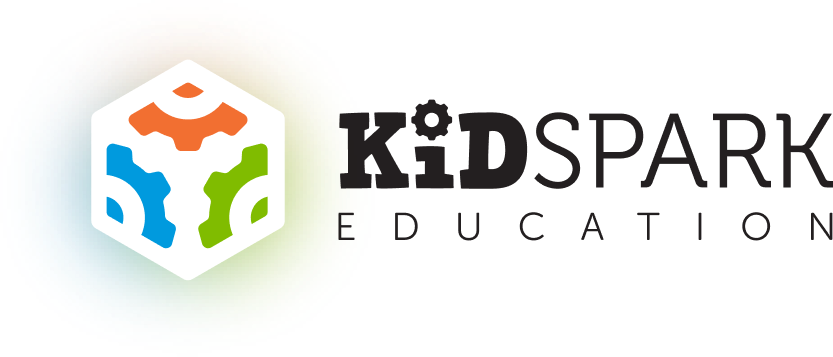
For elementary school students, it is paramount that they get STEM education early and consistently throughout their education. A key way to add STEM learning to early education is using STEM kits. That’s why, at Kid Spark Education we’re happy to offer our STEM Labs for students in elementary school and beyond. We want to help foster a love of problem solving and scientific thinking that can support students throughout their lives.
We do this with our programs: Foundational Fluencies and STEM Pathways. These labs include age-appropriate building blocks and robotic materials that inspire collaborative learning and, as always, a lifelong love of design and engineering thinking. Having the opportunity to learn hands-on and in the classroom provides the tools needed for students to grow throughout their lives and provides teachers the resources to truly act as STEM mentors.
Still not convinced STEM kits and curriculum are needed in your elementary school classroom? Here are 5 reasons to add STEM labs to your classroom:
1. STEM Kits Offer the Opportunity for Integrated STEM Learning
In our STEM labs, in addition to learning foundational fluencies, students focus on concepts such as how to make things strong, how to make things move, how to measure, how to use a design and engineering process to solve a challenge, and how to design and program robotic systems. As they gain confidence in their ability to author with technology to solve real-world problems, they are also learning about different disciplines of STEM learning. Our labs are designed specifically to teach integrated STEM, which allows elementary school students to understand the concepts on a deeper level.
Integrated STEM often uses Wells & Ernst’s definition, which explains that the teaching approach uses,
“the application of technological/engineering design based pedagogical approaches to intentionally teach content and practices of science and mathematics education through the content and practices of technology/engineering education. Integrative STEM Education is equally applicable at the natural intersections of learning within the continuum of content areas, educational environments, and academic levels”.
By learning hands-on with our STEM labs, students learn all about engineering, science, math, and technology and how each of the disciplines work together. This helps them get even more excited about what STEM can do and what they can learn.
2. Schools Can Provide Necessary Resources that Teachers Need
Having a teacher who is an instructor, role model, and STEM program mentor all in one is critical, especially for elementary school aged students. Teachers who serve as STEM mentors ensure that students stay at their learning edge, the zone where skills and fluency may be just shy of what’s required to accomplish the task at hand. A STEM mentor’s encouragement can mean the difference between a child giving up on STEM and excelling in STEM. That’s why mentors need to also be up to date with the curriculum and training they need to empower their students. To do that, mentors also need to have the tools they need to be able to mentor students.

That’s why it’s so important to have a STEM education program that makes it that much more doable to teachers to teach integrated STEM education. As Stohlmann, Moore, and Roehrig find in their study on integrated STEM education in the Journal of Pre-College Engineering Education Research,
“The preparation and support of teachers of integrated STEM education is essential for achieving these goals. Future research can focus on the development of curricula materials and instructional models for STEM integration, connections between teacher education programs for integration and teachers’ subsequent classroom teaching practices, and also ways in which teachers view STEM integration”
With Kid Spark Education in particular, our STEM kits have robust curriculum resources for teachers to use to teach their students. Our programs are aligned with Next Generation Science Standards (NGSS), International Society for Technology in Education Standards (ISTE), Computer Science Teachers Association Standards (CSTA), and Common Core (CC), so teachers can hit educational outcomes while preparing their students for the modern world. On the curriculum page on our website, registered teachers can take a look at the curriculum and how to effectively use our kits to inspire a lifelong love of STEM.
3. Professional Development Opportunities Benefit Everyone
In addition, because mentorship is so important to fostering a STEM identity and technology fluency in elementary school students, we offer professional development training for the instructors that use our programs. Professional development for teachers and other stakeholders in STEM programs is proven to foster even greater educational outcomes. In fact, in a study for the Journal of Technology Education, researchers found that professional development (PD) was,
“key to success in implementing integrative STEM education is providing opportunities for stakeholders, including teachers and administrators, to develop a shared passion
for preparing students in meaningful ways to solve real-world challenges. With this type of PD, teachers are more confident and prepared to work with students in approaching problem-solving through a multidisciplinary method. Ultimately, through PD opportunities, teachers and administrators can model for students what it looks like to be engaged, lifelong learners who strive to impact children and the larger community.”
At Kid Spark Education, our professional development is expressly designed to work with our programs and foster that sense of mentorship that is so important. As Estapa and Tank explain in their study on integrated STEM in elementary school classrooms, Professional development “must be active, sustained, coherent, collaborative, reflective, and focus on content knowledge in order to lead to real changes in practice”. With our professional development resources and getting professional development with other instructors at other events, teachers can truly ensure that their STEM program changes their elementary school students’ lives.
4. STEM Education Teaches Students Key Problem Solving Skills
Just like reading, STEM concepts are an essential tool for understanding and interacting with the world. Kids who are “STEM fluent” learn to think critically, solve creatively, and engage fearlessly with the world around them. By providing tools to support STEM education, from toddler to teen to teacher, Kid Spark helps kids develop the courage to imagine a better world and the skills to create it. As Vince Bertram, President and CEO of Project Lead The Way, Inc, explains in WIRED,
“In America, we must make core subjects like math and science relevant for students, and at the same time, foster creativity, curiosity and a passion for problem solving. That’s what STEM education does. STEM is about using math and science to solve real-world challenges and problems. This applied, project-based way of teaching and learning allows students to understand and appreciate the relevancy of their work to their own lives and the world around them. Once they grasp core concepts, students are able to choose a problem and use their own creativity and curiosity to research, design, test and improve a viable solution.”
Our STEM labs provide the opportunity to foster that curiosity, allowing students to learn to see like designers and think like engineers. By learning how to do things like robotics, coding, prototyping, 3D printing, and more, students can understand STEM concepts even better while having fun.
5. STEM Labs Can Be Used Year After Year
Because teachers at elementary school may be teaching at different age groups, it’s important to have STEM learning tools that all students can work from. At Kid Spark Education, our elementary and middle school programs are comprised of progressive units of instruction that cover a range of STEM concepts, and can be used to meet any student where they are. Using our Foundational Fluencies Labs that cover K-1st Grade and our STEM Pathways Labs for 2nd-8th grade, multiple age groups of students can learn to solve problems and build out scientific concepts.

With our progressive curriculum resources, you can ensure that you’re teaching the right STEM concept for the right group and progress through units as you go. By using the same STEM lab kits with different curriculum, you can teach newer ways to solve problems creatively, without needing to buy new kits for every age group.
Ready to Get Kid Spark Education For Your Elementary School Classroom?
Of course, this is just a quick overview of the benefits of using STEM lab kits in your elementary school classroom. If you’re interested in learning more about adding Kid Spark Education programs at your school, we’d be happy to talk to you about this further.
With Kid Spark, students learn to see like designers and think like engineers, so that they have the skills to change the world. Ultimately these experiences help students develop a lasting interest in STEM for years to come. Learn all about our Elementary and Middle School STEM programming here. If you would like to bring Kid Spark Education to your classroom, purchase programs here.

